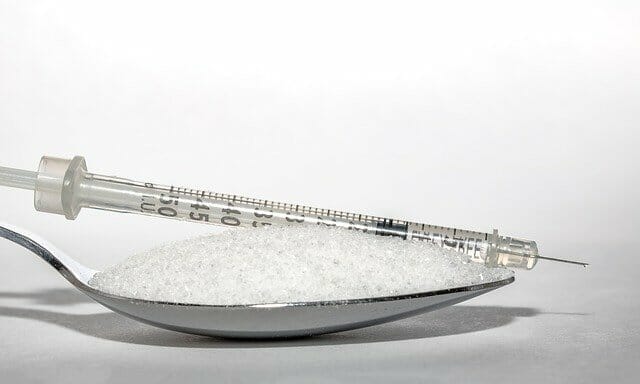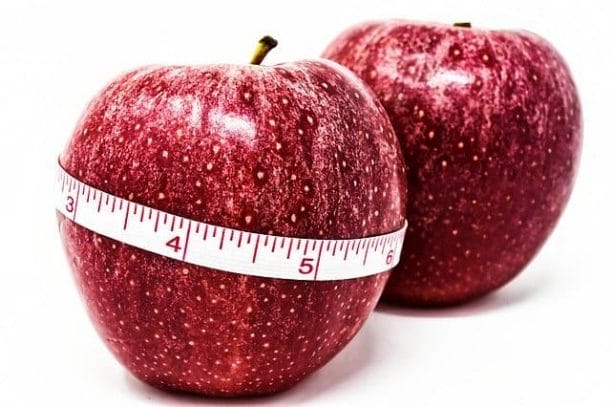Too high level of sugar is one of the most common health problems today, resulting mainly from an improper diet. Cyclically increased sugar may lead to diabetes and its numerous, often very dangerous for health and life complications. Are you struggling with blood glucose level fluctuations? Do you suffer from worsening of mood and health because of them? Do you struggle with weight gain? Read the article and learn how to lower sugar – with a few simple lifestyle changes you can avoid serious problems and keep your body weight under control.
Table of contents
Elevated sugar – why is it so dangerous?
Hyperglycemia (over-sugarosis), i.e. increase of glucose concentration in blood, is a condition which cannot be underestimated. Repeated episodes of too high sugar level are a prelude to type 2 diabetes, however it does not have to continue in the form of disease development.
A lot depends on us, because in fighting pre-diabetes and minimizing the risk of diabetes, the most important thing is prevention, consisting mainly of a proper diet and a healthy lifestyle.
Notoriously repeated state of elevated blood sugar is a simple way to insulin resistance. It is an imbalance in sugar metabolism, consisting in decreased sensitivity of tissues to insulin (a hormone responsible for regulating the level of glucose in the blood). As a result, more and more insulin is produced, but despite this, more and more difficulties arise in getting the high sugar down.
In the case of insulin resistance, rapid fluctuations of glucose levels in blood occur (over- and underdosing), which often result in attacks of ravenous hunger and sudden, uncontrollable sleepiness after a meal. It’s worth adding that such carbohydrate imbalance as prolonged high sugar level or sudden sugar jumps and falls may have negative influence on the whole body work (the nervous, digestive and circulatory systems suffer from hyperglycemia).

The more often we deal with elevated blood sugar and the longer insulin resistance persists in the body, the greater the risk that these disorders will develop into type 2 diabetes, the greater the likelihood of cell and tissue damage and impaired functioning of numerous organs.
When we talk about blood sugar levels being too high and when they are correct:
- A blood glucose level between 70 and 99 mg/dl is considered normal.
- A result between 100 and 125 mg/dl (measured on an empty stomach) is considered pre-diabetic (abnormal sugar level).
- A result above 126 mg/dl, at least in two measurements, indicates diabetes.
If the result is lower than 70 mg/dl, we are dealing with hypoglycemia, i.e. too low blood sugar level.
The most common symptoms of hyperglycemia (elevated blood sugar) are:
- drowsiness,
- feeling tired often, no matter what time of day it is,
- visual problems, decreased vision,
- weakness,
- headaches,
- weak immunity, infections that often set in,
- impaired concentration,
- malaise,
- increased thirst,
- dry mouth,
- dry skin, skin problems,
- frequent urination (even at night),
- slow healing of wounds,
- erectile dysfunction,
- sour mouth odor,
- digestive problems.
It is worth adding that the higher the blood glucose level is, the stronger the symptoms of overdiagnosis.
Some negative health effects of chronic hyperglycemia:
- acidosis,
- nerve damage,
- circulation problems, tingling, numbness in the extremities, sensory disturbances, cramps,
- blood vessel damage,
- retinal damage, loss of vision,
- kidney failure,
- increased risk of atherosclerosis, heart attack, stroke.
The most common causes of elevated blood sugar levels:
- eating too many meals,
- too many simple carbohydrates in the diet,
- a diet dominated by processed foods,
- high levels of stress,
- certain illnesses, taking certain medications,
- not taking medication to lower blood glucose levels (in case of diagnosed diabetes),
- sedentary lifestyle.
How to lower sugar? What to do to get it back to normal?
Too high blood sugar and insulin resistance are dangerous for health, but with our proper preventive actions, introduced permanently, it is possible to prevent them, and thus significantly reduce or even reduce to zero the risk of diabetes. Here are effective, repeatedly proven ways to lower the level of sugar in blood. It is best if we implement all of them at the same time, then we have the best chance of eliminating sugar disorders and maintaining full health.
Control your carbohydrate intake!

Excess carbohydrates are a key contributor to elevated blood sugar levels and the development of insulin resistance and then diabetes. However, it’s not all carbohydrates, but specific types.
Complex carbohydrates, including dietary fiber, are safe for people with glycemic disorders, and even recommended, because due to longer digestion time, they lead to slower release of glucose into the blood, thus stabilizing its concentration.
The problem arises in the case of simple carbohydrates which, because of their rapid absorption rate, cause rapid sugar spikes and then intensive insulin secretions resulting in sudden sugar drops. All this leads to acute glycemic fluctuations, which, if they occur frequently, pose a big threat to our health.
There is only one conclusion – we should have carbohydrates under constant control. Their amount in the daily menu should be rational and balanced with the amount of other important nutrients, such as proteins and fats. Avoid simple carbohydrates, such as sweets or highly processed white flour products, and reach for complex carbohydrates, such as those found in whole grains and vegetables.
A table showing the so-called glycemic index (GI) of individual products (which can be found on the internet) can be helpful in planning a menu. Glycemic index is a measure of how quickly the blood glucose level rises after eating a given food. We should choose products with lower GI values.
Recommended carbohydrates:
- whole grain bread,
- thick cereals,
- brown rice,
- wholemeal pasta,
- oatmeal and other cereals,
- bran,
- all vegetables,
- fruit and vegetable shakes,
- fruits with lower sugar content (e.g. strawberries, blueberries, apples, citrus, raspberries, blackberries, peaches).
Carbohydrates not recommended:
- sweets e.g. biscuits, cakes, pies, candies, bars,
- honeys, jams, fruit syrups, sweetened drinks and juices,
- fast food,
- white bread, white flour products,
- instant foods,
- fruits with high sugar content (e.g. bananas, figs, grapes, dates, canned fruits).
Read also: Diabetic diet
Drop the excessive kilograms!
Overweight and obesity are closely related to disordered carbohydrate metabolism. Sudden spikes in blood sugar cause a strong insulin release, which in turn leads to a rapid reduction in glucose levels and “pushing” excess sugar into fat reserves. Hence, many people who eat a lot of foods high in simple carbohydrates report rapid weight gain.
Chronic hyperglycemia is characterized by abdominal obesity (“apple” type of silhouette), in which we deal with the accumulation of fat tissue around the waist.
If you are overweight or obese, you should definitely lose weight to your normal body weight, otherwise you will greatly increase your risk of developing diabetes. Nothing is a bigger enemy of balanced sugar management than excess weight. Increasing our daily exercise and introducing a healthy, light diet, which you’ll read more about in a moment, will definitely help with weight reduction.
Enter a healthy diet!

What should be the characteristics of a menu for a person who, firstly, has problems with too high blood sugar levels, and secondly, wants to lose excessive kilograms or maintain proper BMI? In the first place, it is worth addressing the elimination of what is most fattening and what most threatens the sugar balance, namely carbohydrates with a high glycemic index.
As mentioned above, we mainly use complex carbohydrates, while simple carbohydrates are consumed in the smallest quantities possible, mainly in the form of fruit. We eat plenty of vegetables, replace white flour products with those made from whole grain, avoid processed foods and sweets.
Another important issue is fats. We do not eliminate them completely, but we monitor their amount and type. We reach especially for good types of fats, present in olive oil, vegetable oils, nuts. We limit animal fats. We give up fatty parts of meat at the expense of the leanest ones. We consume cream, fat cheeses, butter from time to time in small amounts (you can replace cream with natural yogurt, fat cheeses with mozzarella, butter with cream cheese or coconut oil).
The daily menu should also not lack the appropriate amount of protein. Such protein products as eggs, cottage cheese, yoghurt, kefir, buttermilk, as well as legumes, seeds and seeds, leaner fish and meat without skin and fat parts are recommended.
To avoid sudden sugar fluctuations, it’s a good idea to eat meals every 3 hours or so. The system of 3 main meals and 2 or 3 snacks works best. Snacks should be based on complex carbohydrates and proteins. And in each main meal both complex carbohydrates, proteins and fats should be present. Fats should occupy about 30% of the energy value of the entire meal, carbohydrates about 45 -50%, and protein about 20%.
If we want to reduce body weight, the presented principles of a healthy diet should be combined with the principle of a reduced calorie menu. However, you can not cut calories too radically, because it threatens the body with exhaustion and yoyo effect. Optimal reduction is about 400-500 kcal per day. So if our daily demand is, for example, 1800 kcal, we should consume about 1300-1400 kcal per day.
Use herbs and supplements to help reduce sugar!
Herbs, or a more convenient form of them – dietary supplements rich in concentrated herbal extracts – can be a great support for people who have problems with maintaining proper blood sugar level. Medicinal plants have the advantage that they work naturally, in accordance with the rhythm of our body, and in addition to helping lower sugar, they have a number of other health-promoting properties.
The best herbs for lowering sugar are:
- white mulberry,
- dandelion,
- nettle,
- rutabaga,
- cinnamon,
- fenugreek,
- forskolin,
- juniper.
Herbal treatments can be highly effective, but they require from us not only regularity and consistency in preparing daily infusions, but also patience – almost all herbs bring effects only after long-term usage. For many people, herbal capsules or tablets for sugar reduction are much more convenient, faster, easier and effective method. A growing popularity has recently been enjoyed by a preparation DiabetersIt contains several strong, natural extracts that counteract sugar spikes in blood and guard proper insulin secretion.
Increase your physical activity!

It’s not a well-known fact today that a sedentary lifestyle is the biggest enemy to good health. Lack of sufficient exercise in everyday life significantly contributes to metabolic disorders, overweight and obesity, spine diseases, joint ailments, hypertension and other cardiovascular diseases, intestinal disorders, varicose ve ins, etc.
Lack of exercise is also the enemy of efficient carbohydrate metabolism and normal blood sugar levels. One of the basic recommendations for people with diabetes or pre-diabetes is regular physical activity.
As a result of increased exercise, metabolic processes are stimulated, sugars supplied in the food are used as an energy source for the muscles, blood glucose levels are reduced and insulin production is normalized. The sensitivity of tissues to insulin also improves, the immunity of the body increases and the level of fat tissue decreases.
Therefore, it is definitely worth taking care of a solid portion of exercise every day, and we will quickly notice the benefits in the form of lower glycemia and improvement of the condition of the whole organism. However, it is worth asking a question which forms of activity are recommended for people with blood sugar disorders?
Especially recommended are aerobic (aerobic) exercises, consisting of moderate physical activity for a long time (min. 30-40 minutes). These may include: walking, trotting, walking/running, moderate jogging, cycling, nordic walking, swimming, exercising on exercise machines such as treadmills, stationary bicycles or orbiters, dancing, aerobics.
Hydrate your body!
Although it is relatively little talked about, keeping the body well hydrated helps to maintain normal sugar levels. Therefore, if we tend to have high glycemia, we should make sure to consume enough fluids, especially water. About 1.5 liters of mineral water a day, divided into smaller portions and sipped throughout the day, is a great way to lower blood glucose levels.
Avoid stress!
When we are in stressful situations or experiencing high nervous tension, stress hormones are produced, under the influence of which a number of reactions occur in our body. Among others it comes to: accelerated breathing, increased blood circulation, palpitations, dilated pupils, stimulation of metabolic processes, and also, importantly for diabetics and people with glycemic disorders, increased blood sugar levels. Therefore, if stress is our frequent companion, we are constantly exposed to increases in blood glucose, and our fight for normal glycemia is strongly disrupted.
For the sake of our health, we should avoid all nervous situations and learn to control stress and emotions. Maintaining mental balance, relaxation and stress relief is favoured by, among others:
- a sufficiently long, healthy sleep,
- Rest during the day (e.g. nap, relaxing bath, reading, etc.),
- meditation, yoga,
- physical activity,
- breathing exercises,
- relaxing gymnastics,
- developing hobbies in life, indulging in favourite activities.
A healthy lifestyle is not only a way to fight high blood sugar or stop diabetes, but also a method to maintain vitality, good body condition, youthfulness and excellent well-being for many, many years.

